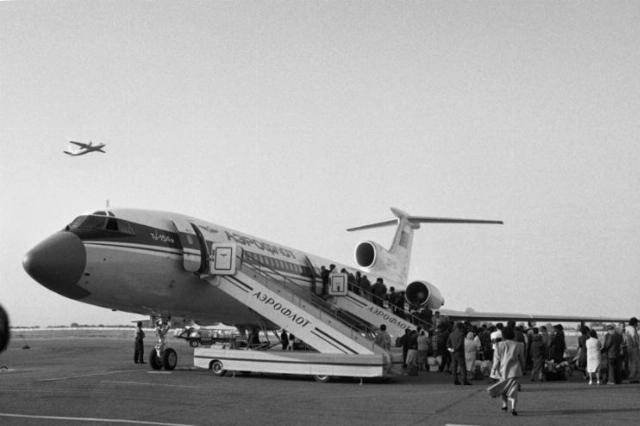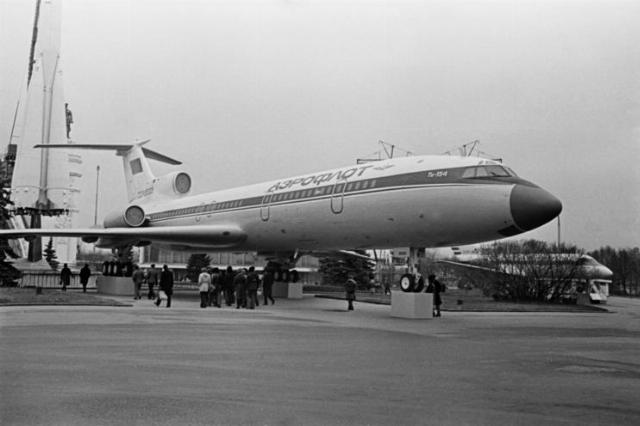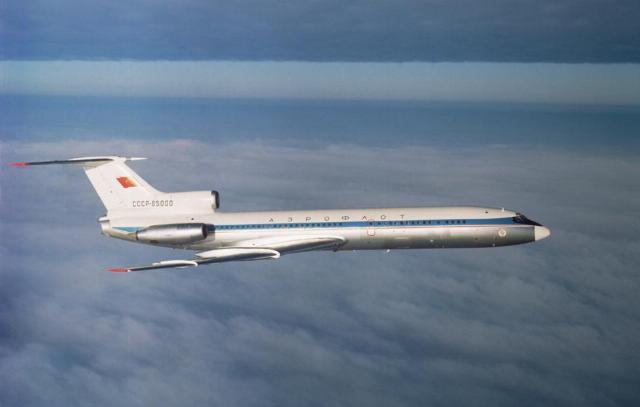Five years ago, on October 28, 2020, the Tu-154 made its last civilian flight in Russia. We are talking about the latest aircraft created under the leadership of Andrey Tupolev.
With optimism for the future
In the 1960s, there was every reason to believe that air transport would soon become one of the main means of transporting passengers. However, the well—proven passenger aircraft models - the Tu-104 jet and the An-10 and Il—18 turboprop - had significant differences from each other, which was inconvenient to operate; they were also becoming obsolete and needed to be replaced with fundamentally new machines. And at the same time, a more advanced type of gas turbine engines appears, which immediately attracts aircraft designers — for passenger ships, this meant an increase in flight performance with increased comfort for passengers.
In addition, it was important to keep up with the new trends in global civil aviation and compete with Western companies by mass-producing a modern passenger aircraft with an eye on both the country's needs and exports.
The Tupolev Design Bureau with the Tu-154 project and Ilyushin with the Il-72 took part in the competition to create such an aircraft. In 1965, a government decree was issued recognizing the first contestant as the winner. The Tu-154 is the last aircraft created under the direct supervision of Andrei Tupolev: according to his instructions, the project of the medium—haul airliner was initially led by Dmitry Markov, then Sergey Yeager. It was decided to assemble the airframe according to one of the then traditional aerodynamic schemes: the wings were low and swept; the aircraft engines were shifted to the tail, with two engines mounted on pylons along the sides of the fuselage and another in the tail fairing under the keel (to reduce noise in the cabin).
Specifications
The first flight of the prototype (tail number USSR-85000) took place on October 3, 1968, just three months after the start of design. The crew was led by veteran Yuri Sukhov, who was later awarded the title Hero of the Soviet Union for his impeccable work, courage and heroism. The following year, the airliner was demonstrated at the international air show in Le Bourget. Then the serial production of the aircraft began at the Kuibyshev Aviation Plant.
 |
| Tu-154 aircraft in the assembly shop of the Kuibyshev Aviation Plant, 1972. |
| Source: © Viktor Shandrin/ TASS |
The staff of the State Research Institute of Civil Aviation began studying the novelty when the car was still on the stocks. Subsequently, it was noted that although the machine had features typical of all Andrei Tupolev jet aircraft, there were also many innovations, for example, in the control system and wing mechanization, which was much more powerful than on all existing aircraft. There were also reversing devices — on two side engines — that allowed, in combination with air brakes and disc brakes (wheels), to dramatically reduce mileage. At that time, the Tu-154 met the most demanding requirements of the international class, surpassing foreign aircraft of the same class in terms of energy efficiency.
Valentin Deloveri, Lead engineer for the state tests of the Tu-154 aircraft
Commercial flights began after the completion of state and operational tests conducted by pilots Boris Anopov and Grigory Nikiforov.
At first, the aircraft seemed difficult to pilot, it had much more mechanical stabilization systems and controls than, for example, the Tu-104, which required performing a large amount of work before takeoff. A special feature of the machine is the requirement for very precise alignment, since erroneous calculations revealed insufficient effectiveness of the elevator. Difficulties arose due to the rear location of the engines: in the parking lot, it was necessary to ensure that the plane did not "fall on its tail" (passengers were first released from the second cabin, and the engineer sometimes had to put a special support under the tail unit; it happened that before the plane was refueled, the pilots were forbidden to leave the cabin). When moving in flight to high angles of attack, say, over 20 degrees, a so-called "pick-up" could occur and fall into a flat spin. A similar incident occurred once during test flights, when the crew and the car were saved by a special anti-corkscrew parachute (all Tu-154s are equipped).
Nevertheless, when mastering the machine, the pilot had additional power; and, for example, the presence of retractable slats and interceptors to change the lifting force of the wing ensured a decrease in landing speed. Having three engines reinforced a sense of confidence: even if one engine failed, it was quite possible to safely take off and then land the plane on two. As a result, with the development of everything that was embedded in the design, the Tu-154 became one of the best Aeroflot aircraft.
 |
| Tu-154. |
| Source: Rafik Gafurov/ TASS |
However, they constantly tried to modernize it: the control system for slats and flaps on the Tu-154A improved, which increased the stability of the aircraft; the fuselage of the Tu-154B was lengthened by a meter and the number of passengers increased from 158 to 180 at maximum load; in addition, it received an automatic landing system. In 1982, under the leadership of Alexander Shengard (he took over the position of chief designer of the program from Sergey Yager), work began on further refinement of the aircraft (more significant than before). The main point of modernization was the replacement of the original Nikolai Kuznetsov NK-8 engines with Pavel Solovyov D-30 engines, which proved themselves well on the Il-62 and Il-76 and reduced fuel consumption by almost 8% per kilometer. So three years later, the Tu-154M appeared.
The most massive mainline aircraft of the USSR
In the five to six years since the start of serial construction, the airliner entered almost all the main Aeroflot units, as five to six cars were delivered per month. A significant number of Tu-154s were also purchased by other countries, mainly those that were part of the Soviet bloc. The first transatlantic flight on the Tu-154 was carried out by the Bulgarian airline Balkan. Largely due to this creation of the Tupolev Design Bureau, by 1980, the share of air transport in intercity services increased from 24 to 32.4% and took second place after rail. So, this year, about 1,000 flights per day were carried out on these airliners and about 100 thousand passengers were transported. Of the 34 main operational divisions of Aeroflot, 29 had them at the end of 1990.
It can be assumed that every adult resident of the Soviet Union who used the services of our oldest airline took to the skies on the one hundred and fifty-fourth at least once in his life.
 |
| Tu-154 presidential aircraft, 1992. |
| Source: © Valery Bushukhin/ TASS |
At the same time, one of the operators was the 235th government detachment of Aeroflot (in 2009 it was separated from the GKT Rossiya into the special flight detachment Rossiya) - in 1995 there were several Tu—154M aircraft that were used on long-range routes and had long-range and satellite communication systems that worked in the interests of the president, as well as nine other cars — to ensure the flights of members of the government. At the same time, the Russian Air Force had about 20 aircraft in operation, mostly transport aircraft, as well as several Tu—154T flying hospitals and a Tu—154C cargo variant (which for the first time in our country had a large cargo door on the side of the fuselage). One Tupolev Design Bureau airliner of this type was used to train astronauts.
According to the Tupolev Design Bureau, a total of 932 Tu-154s of various modifications were built during production from 1969 to 2013.
Meanwhile, in 1964, the United States created the Boeing 727 airliner, which was widely used not only in the United States, but throughout the world. It is impossible not to note some external similarities between the Tu-154 and the Boeing 727-100. Nevertheless, as a larger aircraft, the Tu-154 could accommodate 25-30 more passengers and could carry 2.5 tons more commercial load. At the same time, Boeing had the ability to enter small airports, had a slightly higher cruising speed, and its landing gear design made the aircraft lighter. A later version, the Boeing 727-200— already had similar weight and capacity data to our airliner. In short, they were worthy competitors in the fight for the passenger.
Not without incident
Unfortunately, during intensive operation, flight accidents occurred. The first plane crash of this type of aircraft occurred on February 19, 1973 at Prague-Ruzine Airport (Vaclav Havel International Airport). Upon landing, the Tu-154, which arrived from Moscow, suddenly went into a rapid descent, crashed into the ground, as a result of which it collapsed. Of the 100 people on board, 66 died.
The incident on November 17, 1990 ended without human casualties, but also with the destruction of the airliner — an emergency landing in a field 120 km east of Prague near the village of Dubenets. Then, when returning from Basel with a cargo of cigarettes, a fire broke out on board the Tu-154M, but it could not be extinguished. Commander Viktor Stolyarov decided to descend; soon, with its nose raised, the airliner touched down, crashed into an embankment, collapsed and burned down. All six crew members managed to get out safely. Many Czech newspapers later noted not only the luck of our aviators, but also their high skill. "Hats off to the pilots — these are true professionals," wrote the local newspaper Práce.
A unique case occurred with the Alrosa Tu-154M airliner, which operated a passenger flight from the Yakut city of Udachny to Moscow on September 7, 2010. 3.5 hours after takeoff, the power supply on board was lost, which led to the shutdown of all navigation systems and the electric drive of the fuel pumps. The crew (commander Evgeny Novoselov) made an emergency landing at the former Izhma airport (Komi Republic) on the decommissioned runway without the necessary equipment (it was only periodically cleared at the initiative of the head of the nearby helipad Sergey Sotnikov). Despite the fact that the plane rolled out of the "concrete", none of the 72 passengers and nine crew members were injured. Moreover, the airliner was repaired and returned for further operation on scheduled airlines.
One of the most famous disasters was the downing of the Tu-154 of Polish President Lech Kaczynski on April 10, 2010 near Smolensk. There were 96 people on board the plane who were flying to mourning events in Katyn. According to the IAC investigation, the cause of the crash was the wrong actions of the crew. As a result, the President of Poland, his wife and many representatives of the country's leadership were killed.
Memory
Fortunately, the Tu-154 is not associated with accidents by the general public. Even his participation in the filming of the Soviet disaster film "The Crew" (1979), in my opinion, did not leave any negative impression. Interestingly, two Tu-154s took part in the filming at once. The first one was under repair at that moment after the fire, but since the tail section survived, it was quite suitable for director Alexander Mitte and the film group to work with. The second plane was damaged while transporting a toxic metal, mercury, and had to be written off. But the cinematographers, observing the necessary precautions, used the car and shot the necessary film frames.
 |
| Tu-154 aircraft at VDNKh, 1977. |
| Source: © Nikolay Kuleshov/ TASS |
Monuments to the legendary aircraft have been erected at a number of airports and training centers in the country. The most famous in The Russian exhibit aircraft (Tu-154 No. USSR-85005) was one of the few surviving prototypes, which was turned into a ground museum and placed on the territory of the VDNH for almost forty years, in front of the Aviation and Cosmonautics pavilion. During the museum's existence, before it was dismantled in 2008, the liner was visited by millions of people.
Dmitry Khazanov, member of the Association of Historians of the Second World War, Candidate of Technical Sciences

